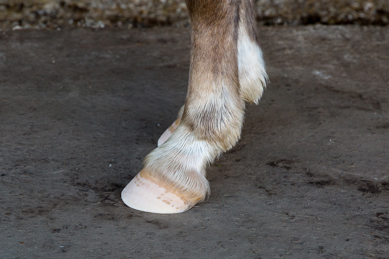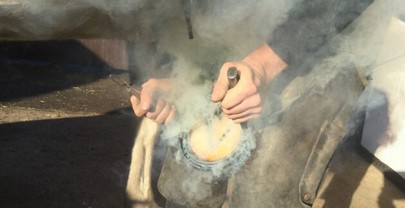The second of our February Foot Focus series ran in conjunction with the British Farriers and Blacksmiths Association (BFBA) and matched the success of our first session with all tickets selling out. This week’s focus was on keeping feet in great shape and two more experts joined the conversation alongside Erik.
Keeping barefoot hooves healthy
Erik introduced Mark Johnson as the first presenter of the evening. Mark is a qualified farrier with 40 years’ experience. Over the last few years Mark has altered his business, focussing on working with clients whose horses are kept barefoot.
Mark took us through the reasons behind his decision to stop applying metal horseshoes and become an advocate of horses going barefoot. His main reason was that the horses which weren’t wearing metal shoes looked, in his opinion, to have healthier feet. Mark spoke in detail about the functional anatomy of the hoof and how delicate the internal structures are. Although Mark has chosen not to incorporate steel shoes into his work, he does accept that shoes have been the best tool for hundreds of years and have improved horse welfare over this time.

Not every horse is going to be comfortable being barefoot, however there have been numerous improvements in the use of hoof boots. Mark showed us how to measure the hoof to make sure the correct fit is achieved and encouraged seeking the advice of someone more experienced to help you out. He also touched on remedial farriery and how work has started on researching the use of hoof boots to aid and support injuries and conditions which would traditionally require a steel application.
Whole horse health is paramount in keeping horses’ feet healthy. Mark believes movement and diet are key to producing strong and healthy foot growth. Mark emphasised that although he’s not an equine nutritionist, he has a duty as a professional to have knowledge in this area so he can better help the horses in his care.
If barefoot or hoof boots don’t suit an individual horse, then Mark will use a composite shoe to support the health of the hoof by either nailing or gluing the shoe on. These shoes are flexible and mirror the mobility of the barefoot hoof.
“My remit, I believe, is to know when I have a metabolic issue with a horse going on. I need to be able to read the symptoms, whether they're good or bad. And in that case, I'm acting like a GP. I then want the specialist to come in.”
Getting the best out of a set of shoes
Sarah Brown FWCF has a vast amount of experience. She has a huge interest in keeping the horse barefoot where possible, but in cases where the horse needs more support, she will hand-make their shoes.
Sarah introduced her presentation by talking through a farrier’s decision-making process and the factors which can influence that decision such as: type of work, workload, type of horse, environment and owner expectations.
Sarah talked about what farriers want to achieve with a trim, for weight-bearing and loading capacity, and that she can mimic that using the shoe. To achieve this they can use set toes, rolled toes and rocker toe shoes to achieve the same trimming principle when shod.

Remedial shoeing, Sarah explained, is shoeing for a specific condition or pathology held by a horse to support them through differing mechanics. She also explained that not every horse with a pathology will need specialist shoeing and neither will every horse have to be shod with a steel shoe as Mark previously explained.
Sarah then went on to explain how horse owners can get the best out of a set of shoes and the advice is very simple:
- Maintain a regular shoeing cycle
- Regularly pick out feet
- Provide good, dry turnout (or a dry place to stand)
- During summer months, shoe the horse before it becomes overdue
“So, to get the best out of a set of shoes, actually, it's false economy to push them as long as you can. In fact, it's much better to get them done slightly earlier in the summer months to leave the feet in better condition.”
A lengthy question and answer session followed the presentations which brought about some great discussions. Questions such as the differences between a barefoot trim and a shod trim were answered as well as questions covering diet, fitting boots to heavily feathered horses and hoof balance.
To watch the webinar back in full click here
Monday 20 February will see Erik host the final instalment to the series. Aksel Vibe and Ben Benson will be discussing competition, surfaces and rules. To join the conversation please sign up by visiting our ticketing partner here.
Get in touch – we’re here to help
The BHS Horse Care and Welfare Team are here to help and can offer you further advice with any questions you may have. Contact us on 02476 840517* or email welfare@bhs.org.uk – You can also get in touch with us via our social media channels.
Opening times are 8:35am - 5pm from Monday – Thursday and 8:35am - 3pm on Friday.
*Calls may be recorded for monitoring purposes.

